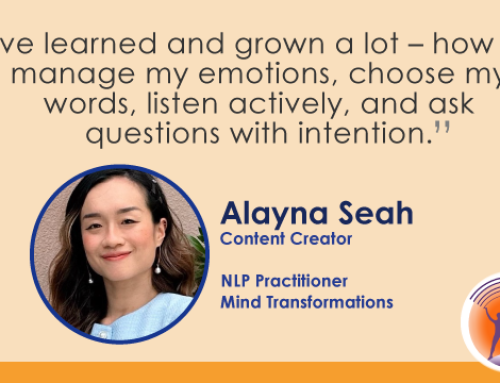by Cathy Lee
We often encounter blocks and hurdles in our attempt to resolve conflicts, resulting in avoidance of the issues, allowing conflicts to brew and subsequently blow up or we give up altogether. Many times, I’ve had managers walk into my room throwing their arms in the air and complaining about someone who can’t understand, won’t listen, or refuses to cooperate. Here is how I effectively coach my team to handle conflicts at work.
A specific example would be a brand manager who was feeling discouraged and de-motivated because another staff member just shouted at her.
She felt really low and questioned her own capabilities. In her mind, she was defeated, working all alone and couldn’t rally support from her colleagues. Her deadlines were fast approaching and she just couldn’t cope with it.
I paced her.
I demonstrated my understanding of her issues by mirroring and matching her body language. We started talking about other things and settled around a recent vacation she had. I asked her to talk about a place she really enjoyed. She then told me about a visit to a church where she really felt peace. At this instant, I anchored her by telling her to put her hands on her chest, close her eyes and enjoy that peaceful feeling. Anchoring is a technique to trigger a feeling or mood of well-being at will.
I then asked her to recall the incident that frustrated her earlier.
Up to the point when she mentioned the negative response from the irritating colleague, I took her hand and guided it to her heart. She just stopped and there was a definite softening in her face. I asked her to carry on, but she said she couldn’t. When asked to describe her feeling, she said she was conscious that I was reminding her of the church. I encouraged her to touch her heart when she felt herself getting agitated or discouraged.
We talked about limiting beliefs and I assured her that she already had all the resources within her to act effectively. She began to feel much more confident.
I also gave her some suggestions on how to build rapport with her colleagues and get them to collaborate with her. We spent 10 minutes working out an activity plan so she had better control of her time. She left my room in a very different state from when she first came in.
Nowadays, when she comes to my room, she’s usually smiling.
She is quick to share her successes of how she overcame objections from colleagues. Still, there are times when she feels down but when she walks into my room, she’s consciously aware that she needs to question her beliefs and put whatever limitations out of her mind. I still test the hands on the heart feeling from time to time, and she has consistently recalled the feeling.
Cathy Lee is a Human Resource Director with one of the largest beverage companies in the industry. She is responsible for the development of human resource strategies and implementation of leading edge human resource practices. She received the NLP Practitioner Certification in December 2002.
[inf_infusionsoft_inline optin_id=”optin_2″]






